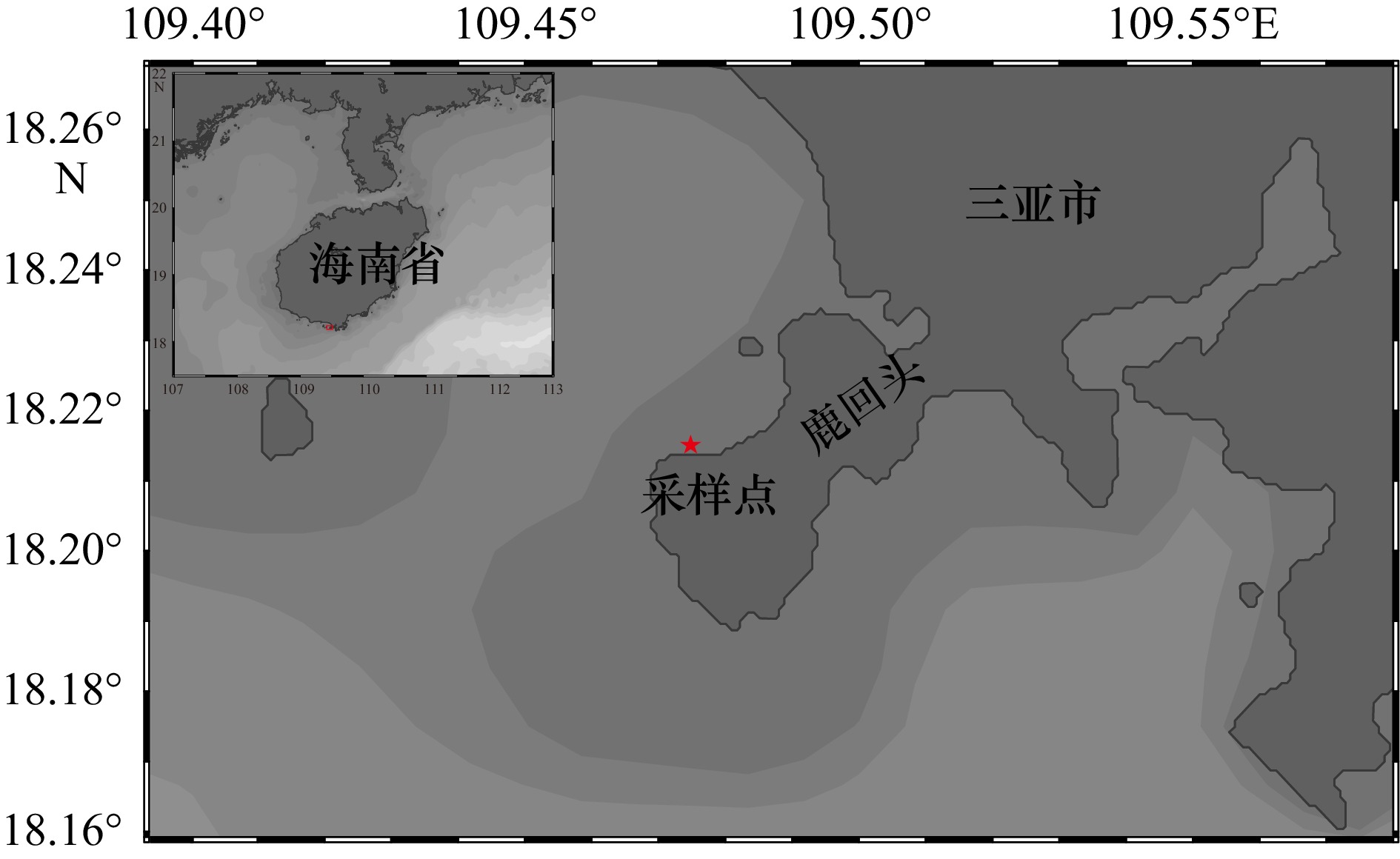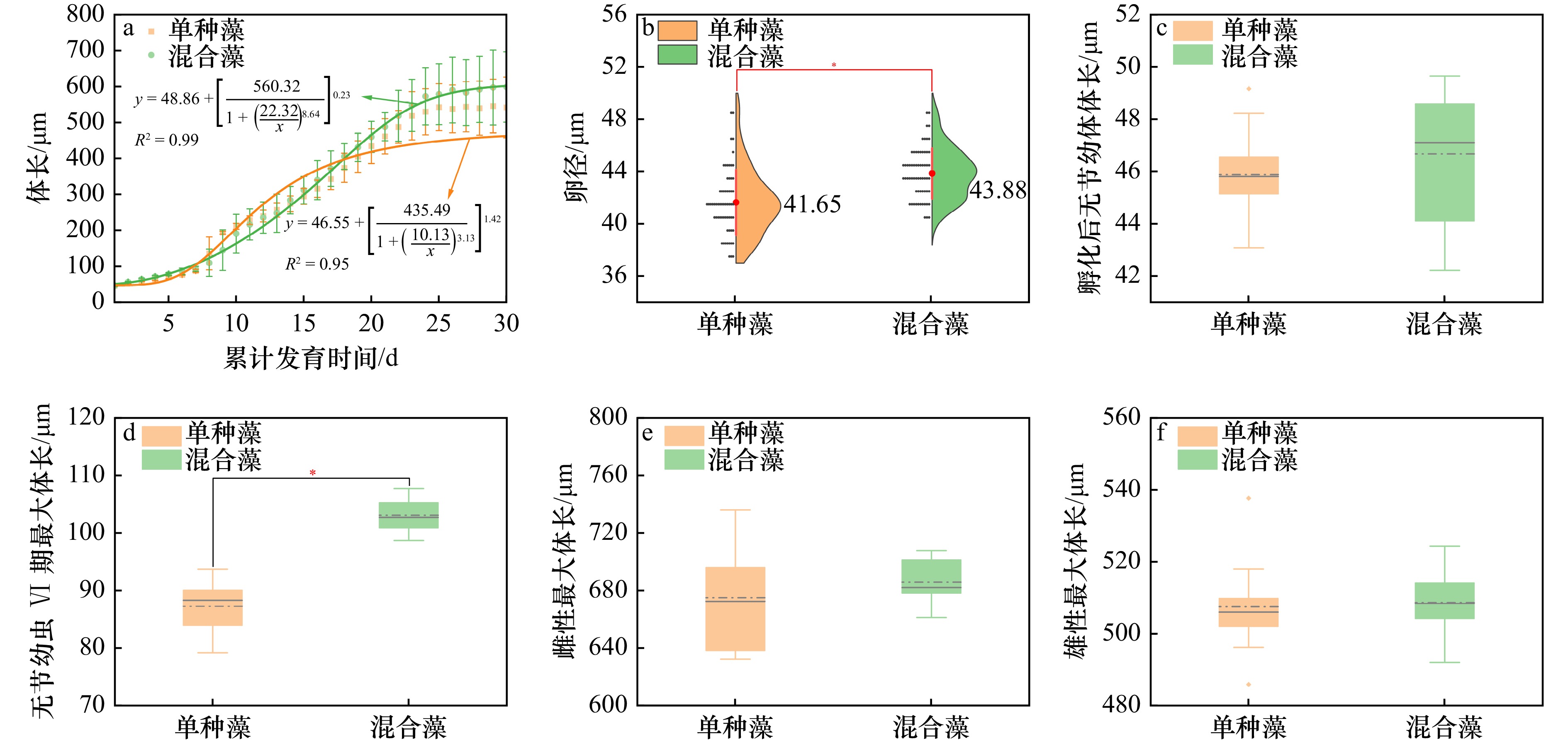Effects of different diet culture the developmental process of the Robertgurneya sp.
-
摘要: 猛水蚤是分布广泛的小型底栖桡足类,在珊瑚礁区的礁石表生藻席中尤为丰富,由于其生境特殊性,目前对发育过程、培养条件的研究较少。本研究于2023年夏季在海南三亚鹿回头珊瑚礁区采集礁石表生藻席,从中分离出一种猛水蚤,经形态学鉴定其属于罗格尼猛水蚤属(Robertgurneya sp.)。在实验室内对其基本发育过程进行观察和记录,并研究了不同饵料培养方式(单种藻和混合藻)对其发育过程的影响。结果显示,罗格尼猛水蚤的成体体长为0.5~0.7 mm,生命周期为61~68 d。单次怀卵量、产卵次数、繁殖周期和生命周期在不同饵料培养下没有显著差异,但在混合藻培养下,罗格尼猛水蚤在胚胎发育期的平均卵径、孵化率、幼体存活率、无节幼虫Ⅵ期的最大体长明显高于单种藻培养组(p < 0.05),且其胚胎发育阶段和桡足幼体期的累计发育时间明显较短(p < 0.05)。研究结果表明,该猛水蚤具有较短的生命周期和较强的繁殖能力,鉴于藻席中存在丰富的底栖微藻和有机碎屑,栖息其中的猛水蚤可能能够为珊瑚礁小型鱼类等捕食者提供巨大的潜在食物资源,因此在珊瑚礁生态系统的物质循环和能量流通中发挥着重要的作用。Abstract: Benthic harpacticoid copepods are widely distributed in marine ecosystem, which is particularly abundant in the epilithic algal matrix(EAM) of coral reefs. Due to its unique habitat, there is currently limited research on its developmental process and cultivation methods. In this study, we collected epilithic algal matrix from the coral reef of Luhuitou, Sanya, Hainan in the summer of 2023, from which we isolated one species of Harpacticoida, which was belonging to the genus Robertgurneya based on morphological characteristics. The effects of mono-and mixed-algal cultures on the developmental dynamics of Robertgurneya sp. were observed and recorded. The results showed that the adult body length of the Robertgurneya sp. was 0.5−0.7 mm, with an average life cycle of about 61−68 days. There were no significant differences in egg number per female each time, brood number, reproductive cycle, and life cycle between different feed cultivation techniques. However, under mixed algae culture, the average egg diameter, larval survival rate, and maximum body length of nauplii stage VI in the embryonic development stage of the Robertgurneya sp. were significantly higher than those in the mono-algae culture group (p < 0.05). Moreover, the embryonic development time and cumulative copepodid development time were significantly shorter under mixed-algal culture (p < 0.05). The results indicate that Robertgurneya sp. in EAM have a short life cycle and strong reproductive ability. Considering the abundant benthic microalgae and organic debris in the mats, harpacticoida may be able to provide huge potential food resources for predators such as small fish in coral reefs. Therefore, it may play an important role in the material cycle and energy flow of coral reef ecosystems.
-
Key words:
- harpacticoida copepods /
- coral reefs /
- epilithic algal matrix /
- diet /
- cultivation methods /
- developmental process
-
图 2 罗格尼猛水蚤在胚胎发育期的形态变化
A. 交配受精;B. 多细胞期;C. 壳状胚胎期;D. 附肢原基出现期;E. 色素形成期;F. 眼点出现期;G. 破膜孵化
Fig. 2 Morphological variation during embryonic development of Robertgurneya sp.
A. Ovulation phase; B. multicellular stage; C. formation of carapace type embryo; D. appearance of appendage anlage; E. formation of pigment; F. appearance of eyespot; G. hatching
表 1 不同饵料培养对罗格尼猛水蚤繁殖周期、产卵次数、生命周期的影响
Tab. 1 Effects of different diet cultivation on the reproduction cycle,brood number and life cycle of the Robertgurneya sp.
营养类型 繁殖周期/d 产卵次数/只 生命周期/d 单种藻 24.60 ± 1.14b 6.60 ± 0.55b 64.6 ± 3.36b 混合藻 23.80 ± 0.84b 7.40 ± 0.89b 65.4 ± 4.51b 注:相同字母代表不同饵料培养对罗格尼猛水蚤的繁殖周期、产卵次数及生命周期在p < 0.05 水平上无显著差异。 -
[1] 连光山, 孙柔鑫, 王彦国, 等. 中国海及其邻近海域猛水蚤桡足类多样性[M]. 北京: 科学出版社, 2022.Lian Guangshan, Sun Rouxin, Wang Yanguo, et al. Species Diversity of Marine Harpacticoid Copepods in China’s Seas and Adjacent Waters[M]. Beijing: Science Press, 2022. [2] 马林. 中国海底栖桡足类的分类学研究[D]. 青岛: 中国科学院研究生院(海洋研究所), 2011.Ma Lin. Study on the taxonomy of benthic copepods in the China seas[D]. Qingdao: Institute of Oceanology, Chinese Academy of Sciences, 2011. [3] Willen E. A new species of Stenhelia (Copepoda, Harpacticoida) from a hydrothermal, active, submarine volcano in the New Ireland fore-arc system (Papua New Guinea) with notes on deep sea colonization within the Stenheliinae[J]. Journal of Natural History, 2003, 37(14): 1691−1711. doi: 10.1080/00222930110114437 [4] 程浩楠, 王淑红, 程方平. 海洋桡足类作为生物活饵料的研究进展[J]. 海洋渔业, 2020, 42(4): 490−501.Cheng Haonan, Wang Shuhong, Cheng Fangping. Research progress on marine copepods as live prey[J]. Marine Fisheries, 2020, 42(4): 490−501. [5] 张志南, 周红, 华尔, 等. 中国小型底栖生物研究的40年——进展与展望[J]. 海洋与湖沼, 2017, 48(4): 657−671.Zhang Zhinan, Zhou Hong, Hua Er, et al. Meiofauna study for the forty years in China ——progress and prospect[J]. Oceanologia et Limnologia Sinica, 2017, 48(4): 657−671. [6] 曾艳艺, 黄小平. 日本虎斑猛水蚤的重金属急性毒性及其作为标准测试生物的潜在意义[J]. 生态毒理学报, 2011, 6(2): 182−188.Zeng Yanyi, Huang Xiaoping. Acute toxicity of heavy metals to Tigriopus japonicus and its implication as a standard test animal[J]. Asian Journal of Ecotoxicology, 2011, 6(2): 182−188. [7] 罗海业. 南海中北部珊瑚礁区草皮海藻分布特征及其对石珊瑚的潜在影响[D]. 南宁: 广西大学, 2019.Luo Haiye. The distribution characteristics of turf algae and its potential effect on scleractinian coral in the reefs of min-northern South China Sea[D]. Nanning: Guangxi University, 2019. [8] Connell S D, Foster M S, Airoldi L. What are algal turfs? Towards a better description of turfs[J]. Marine Ecology Progress Series, 2014, 495: 299−307. doi: 10.3354/meps10513 [9] Wilson S K, Bellwood D R, Choat J H, et al. Detritus in the epilithic algal matrix and its use by coral reef fishes[J]. Oceanography and Marine Biology, 2003, 41: 279−309. [10] Tebbett S B, Bellwood D R. Algal turf sediments on coral reefs: what's known and what's next[J]. Marine Pollution Bulletin, 2019, 149: 110542. doi: 10.1016/j.marpolbul.2019.110542 [11] Kramer M J, Bellwood D R, Bellwood O. Benthic crustacea on coral reefs: a quantitative survey[J]. Marine Ecology Progress Series, 2014, 511: 105−116. doi: 10.3354/meps10953 [12] Kramer M J, Bellwood D R, Bellwood O. Large-scale spatial variation in epilithic algal matrix cryptofaunal assemblages on the Great Barrier Reef[J]. Marine Biology, 2014, 161(9): 2183−2190. doi: 10.1007/s00227-014-2495-6 [13] Kramer M J, Bellwood O, Bellwood D R. The trophic importance of algal turfs for coral reef fishes: the crustacean link[J]. Coral reefs, 2013, 32(2): 575−583. doi: 10.1007/s00338-013-1009-1 [14] 周天成. 三亚鹿回头珊瑚礁区礁石表生藻席演化与食源贡献研究[D]. 广州: 中国科学院南海海洋研究所, 2023.Zhou Tiancheng. Studies on the evolution of epilithic algal matrix and their contribution to food sources in Luhuitou fringing reefs[D]. Guangzhou: South China Sea Institute of Oceanology, Chinese Academy of Sciences, 2023. [15] Buffan-Dubau E, Carman K R. Diel feeding behavior of meiofauna and their relationships with microalgal resources[J]. Limnology and Oceanography, 2000, 45(2): 381−395. doi: 10.4319/lo.2000.45.2.0381 [16] Klumpp D W, McKinnon A D, Mundy C N. Motile cryptofauna of a coral reef: abundance, distribution and trophic potential[J]. Marine Ecology - Progress Series, 1988, 45(1/2): 95−108. [17] Guidi L D. The effect of food composition on ingestion, development, and survival of a harpacticoid copepod, Tisbe cucumariae Humes[J]. Journal of Experimental Marine Biology and Ecology, 1984, 84(2): 101−110. doi: 10.1016/0022-0981(84)90204-1 [18] Matias-Peralta H M, Yusoff F M, Shariff M, et al. Reproductive performance, growth and development time of a tropical harpacticoid copepod, Nitocra affinis californica Lang, 1965 fed with different microalgal diets[J]. Aquaculture, 2012, 344−349: 168−173. doi: 10.1016/j.aquaculture.2012.02.026 [19] Pinto C S C, Souza-Santos L P, Santos P J P. Development and population dynamics of Tisbe biminiensis (Copepoda: Harpacticoida) reared on different diets[J]. Aquaculture, 2001, 198(3/4): 253−267. [20] 蒋霞敏, 郑亦周. 14种微藻总脂含量和脂肪酸组成研究[J]. 水生生物学报, 2003, 27(3): 243−247. doi: 10.3321/j.issn:1000-3207.2003.03.005Jiang Xiamin, Zheng Yizhou. Total lipid and fatty acid composition of 14 species of mircoalgae[J]. Acta Hydrobiologica Sinica, 2003, 27(3): 243−247. doi: 10.3321/j.issn:1000-3207.2003.03.005 [21] 高秀芝, 蒋霞敏, 张泽凌, 等. 5株新分离海洋硅藻总脂和脂肪酸组成的比较研究[J]. 生物学杂志, 2014, 31(1): 60−63,81. doi: 10.3969/j.issn.2095-1736.2014.01.060Gao Xiuzhi, Jiang Xiamin, Zhang Zeling, et al. A comparative study on total lipid and fatty acid composition of five newly isolated marine diatom[J]. Journal of Biology, 2014, 31(1): 60−63,81. doi: 10.3969/j.issn.2095-1736.2014.01.060 [22] 林锡煌, 尹希杰, 袁秋兰, 等. 7种富油微藻的超临界提取及脂肪酸分布特征[J]. 中国粮油学报, 2024, 39(6): 127−132.Lin Xihuang, Yin Xijie, Yuan Qiulan, et al. Supercritical extraction of lipid from 7 microalgae species and fatty acid distribution characteristics[J]. Journal of the Chinese Cereals and Oils Association, 2024, 39(6): 127−132. [23] Carotenuto Y, Ianora A, Buttino I, et al. Is postembryonic development in the copepod Temora stylifera negatively affected by diatom diets?[J]. Journal of Experimental Marine Biology and Ecology, 2002, 276(1/2): 49−66. [24] 李捷, 孙松, 李超伦, 等. 不同饵料对桡足类无节幼体存活、发育的影响研究[J]. 海洋科学, 2006, 30(12): 13−20. doi: 10.3969/j.issn.1000-3096.2006.12.004Li Jie, Sun Song, Li Chaolun, et al. The effects of different diets on the survival and development of copepod nauplii[J]. Marine Sciences, 2006, 30(12): 13−20. doi: 10.3969/j.issn.1000-3096.2006.12.004 [25] 尹洁慧, 季道德, 刘炜炜. 不同浓度海生根鞭毛虫(Oxyrrhis marina)对环小两栖猛水蚤Amphiascopsis cinctus(Claus, 1866)发育时间、存活率、繁殖的影响[J]. 生态科学, 2023, 42(5): 12−18.Yin Jiehui, Ji Daode, Liu Weiwei. Effects of different flagellate (Oxyrrhis marina) concentration to the development, survival rate and reproduction of a benthnic copepod Amphiascopsis cinctus (Claus, 1866)[J]. Ecological Science, 2023, 42(5): 12−18. [26] Miliou H, Moraïtou-Apostolopoulou M. Effects of seven diets on the population dynamics of laboratory cultured Tisbe holothuriae Humes (Copepoda, Harpacticoida)[J]. Helgolä nder Meeresuntersuchungen, 1991, 45(3): 345−356. [27] Lee W Y, Zhang X K, Van Baalen C, et al. Feeding and reproductive performance of the harpacticoid Tisbe carolinensis(Copepoda, Crustacea) in four algal cultures[J]. Marine Ecology-Progress Series, 1985, 24(3): 273−279. (查阅网上资料, 未找到本条文献期号信息, 请确认) [28] Abu-Rezq T S, Yule A B, Teng S K. Ingestion, fecundity, growth rates and culture of the harpacticoid copepod, Tisbe furcata, in the laboratory[J]. Hydrobiologia, 1997, 347(1/3): 109−118. doi: 10.1023/A:1003071318933 [29] 王笑月, 谢玺, 李大成, 等. 几种饵料对分叉小猛水蚤生殖量的影响[J]. 河北渔业, 2017(6): 6−9.Wang Xiaoyue, Xie Xi, Li Dacheng, et al. Effect of several diets on the fecundity of Tisbe furcata[J]. Hebei Fisheries, 2017(6): 6−9. (查阅网上资料, 未找到本条文献英文翻译信息, 请确认) [30] Pinto C S C, Souza-Santos L P, Santos P J P. Development and population dynamics of Tisbe biminiensis (Copepoda: Harpacticoida) reared on different diets[J]. Aquaculture, 2001, 198(3/4): 253−267. (查阅网上资料, 本条文献与第19条重复, 请确认) [31] Fowler S W, Small L F, Kečkeš S. Effects of temperature and size on molting of euphausiid crustaceans[J]. Marine Biology, 1971, 11(1): 45−51. doi: 10.1007/BF00348020 [32] Caramujo M J, Boschker H T S, Admiraal W. Fatty acid profiles of algae mark the development and composition of harpacticoid copepods[J]. Freshwater Biology, 2008, 53(1): 77−90. doi: 10.1111/j.1365-2427.2007.01868.x [33] Arndt C, Sommer U. Effect of algal species and concentration on development and fatty acid composition of two harpacticoid copepods, Tisbe sp. and Tachidius discipes, and a discussion about their suitability for marine fish larvae[J]. Aquaculture Nutrition, 2014, 20(1): 44−59. doi: 10.1111/anu.12051 [34] Yu Juan, Tian Jiyuan, Yang Guipeng. Ingestion, fecundity and population growth of Harpacticus sp. (Harpacticoida, copepod) fed on five species of algae[J]. Aquaculture Research, 2017, 48(5): 2209−2220. doi: 10.1111/are.13057 [35] De Troch M, Chepurnov V, Gheerardyn H, et al. Is diatom size selection by harpacticoid copepods related to grazer body size?[J]. Journal of Experimental Marine Biology and Ecology, 2006, 332(1): 1−11. doi: 10.1016/j.jembe.2005.10.017 [36] Ribeiro A C B, Souza-Santos L P. Mass culture and offspring production of marine harpacticoid copepod Tisbe biminiensis[J]. Aquaculture, 2011, 321(3/4): 280−288. [37] Kramer M J, Bellwood D R, Bellwood O. Cryptofauna of the epilithic algal matrix on an inshore coral reef, Great Barrier Reef[J]. Coral Reefs, 2012, 31(4): 1007−1015. doi: 10.1007/s00338-012-0924-x [38] Ackerman J L, Bellwood D R. Reef fish assemblages: a re-evaluation using enclosed rotenone stations[J]. Marine Ecology Progress Series, 2000, 206: 227−237. doi: 10.3354/meps206227 [39] Fleeger J W. The Potential to Mass-culture Harpacticoid Copepods for Use as Food for Larval Fish[M]//Lee C S, O’Bryen P J, Marcus N H. Copepods in Aquaculture. Ames: Blackwell Publishing, 2005: 11−24. [40] Heath P L, Moore C G. Rearing dover sole larvae on Tisbe and Artemia diets[J]. Aquaculture International, 1997, 5(1): 29−39. doi: 10.1007/BF02764785 [41] Wilson S K, Fisher R, Pratchett M S, et al. Exploitation and habitat degradation as agents of change within coral reef fish communities[J]. Global Change Biology, 2008, 14(12): 2796−2809. doi: 10.1111/j.1365-2486.2008.01696.x [42] Depczynski M, Bellwood D R. The role of cryptobenthic reef fishes in coral reef trophodynamics[J]. Marine Ecology Progress Series, 2003, 256: 183−191. doi: 10.3354/meps256183 [43] Ng D, Taira D, Heery E C, et al. Antagonistic effects of seawalls and urban sedimentation on epilithic algal matrix (EAM)-feeding fishes[J]. Marine Pollution Bulletin, 2021, 173: 113098. doi: 10.1016/j.marpolbul.2021.113098 [44] Wainwright P C, Bellwood D R, Westneat M W, et al. A functional morphospace for the skull of labrid fishes: patterns of diversity in a complex biomechanical system[J]. Biological Journal of the Linnean Society, 2004, 82(1): 1−25. doi: 10.1111/j.1095-8312.2004.00313.x -





 下载:
下载:




